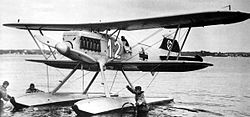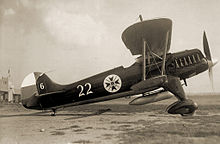Heinkel He 51
| Heinkel He 51 | |
|---|---|

|
|
| Type: | Fighter plane |
| Design country: | |
| Manufacturer: | |
| First flight: |
May 1933 |
| Commissioning: |
July 1934 |
| Production time: |
1934 to 1937 |
| Number of pieces: |
approx. 230 |
The Heinkel He 51 was a biplane - fighter from German production. As a direct development of the He 49 , the He 51 flew for the first time in 1933.
development


Ernst Heinkel developed successful combat aircraft near Albatros and Hansa-Brandenburg as early as the First World War . His prototypes were also used at the Reichswehr's illegal flying school . After he failed to present his He 49 at the Army Weapons Office in 1932 , he simplified its construction for series production and in 1934 received an order from the Reich Aviation Ministry for an initial 75 fighter aircraft . Since the production capacity of Heinkel Flugzeugwerke was not sufficient for this, Erla (80 machines), AGO , Arado and Fieseler were included in the production.
Production numbers
Series production of the He 51 began in February 1935 and ended in December 1936. In 1935 178 and in 1936 320 He 51 were manufactured. In addition, there are some aircraft that were delivered in 1934 or 1937.
| Manufacturer | country | lake | total |
|---|---|---|---|
| EHF | 143 | 31 | 174 |
| ArB | 71 | 2 | 73 |
| Ago | 77 | 77 | |
| Erla | 80 | 80 | |
| GFW | 102 | 102 | |
| total | 473 | 33 | 506 |
commitment
The first He 51A-0 were delivered as early as 1934 and flew in the civil camouflaged, so-called “Central Germany advertising campaign”. In addition to some Arado Ar 65s , the He 51A was part of the initial equipment of the new German Air Force officially founded in March 1935 with fighter planes.
In April 1935, the He 51s were ready for use with the Richthofen Jagdgeschwader in Döberitz . In early 1936, the "Horst Wessel" fighter squadron was the first to receive the improved He-51 B-0 version. On July 31, 1936, 14 He 51s were marched for use in the Spanish Civil War , at the end of 1936 there were already 50 He 51s of the A-1 and C-1 variants in use with the Condor Legion , but could not stand up to the more powerful ones Soviet fighters like the Polikarpow I-16 prevail. The He 51 was, therefore, with the appearance of the Bf 109 mainly used as a low-level attack aircraft. Two He 51A were captured intact by the Republican troops and extensively tested in the Soviet Union, but were considered obsolete there. A total of 93 He 51s were used in Spain.
The He 51 was from 1936 partially from the Arado Ar 68 and 1937 of the 109 Bf replaced as the standard fighter plane of the Air Force. In 1937 twelve machines were handed over to the Bulgarian Air Force. In Germany, the I / JG 136 flew the He-51 as the last Luftwaffe unit until autumn 1938 . The He-51 was used as a trainer aircraft until 1942 .
On March 1, 1940, the Luftwaffe still had 266 He 51 in stock. Aircraft must have been scrapped by now, as no further exports took place after the delivery of 12 aircraft to Bulgaria in 1936. On January 31, 1944, there were 35 aircraft, almost all of which were in schools. That number dropped to 8 on September 30, 1944.
Versions
- He 51A-0: prototypes, nine built
- He 51A-1: Series version of the A-1, 75 built
- He 51B-0: A-1 with reinforced airframe, 12 built
- He 51B-1: Series version of the B-1, 12 built
- He 51B-2: float plane, approx. eight conversions from B-1, approx. 42 newbuildings (also He 51W or He 51B-2W), ship-based catapult aircraft with light bombs
- He 51C-1: ground attack aircraft with underwing stations for four 50 kg bombs, 75 built
- He 51C-2: C-1 with improved radio equipment, 21 built
The He 51W was created as a version with floats , which could easily be converted back to a normal chassis. With the He 51V5 (serial number 994), which received enlarged wings, the altitude performance should be improved, but it remained with a test model.
Technical specifications
| Parameter | Data He-51 C |
|---|---|
| Wingspan above | 11.00 m |
| Wingspan below | 8.60 m |
| length | 8.50 m |
| height | 3.30 m |
| Wing area | 27.20 m² |
| Contents of the fuel tank | 180 l |
| Contents of the lubricant reservoir | 25 l |
| Empty mass | 1615 kg |
| Payload | 285 kg |
| Takeoff mass | 1900 kg |
| Engine | a BMW VI 7.3Z |
| power | 750 hp |
| Propeller | Rigid screw |
| Diameter propeller | 3.10 m |
| Number of blades propeller | 2 |
| Structure | Wooden frame, covered with fabric |
| Fuselage | Tubular steel, light metal, wood, fabric |
| Tail unit | Dural, fabric-covered |
| Flight duration b. Sparlstg. (4000 m) | 2.3 h |
| Flight distance | 730 km |
| for marching performance (2000 m) | 400 km |
| with saving power (4000 m) | 600 km |
| when marching | 160 l / 100 km |
| with savings | 85 l / 100 km |
| Top speed (0 m) | 330 km / h |
| Cruising speed (2000 m) | 310 km / h |
| Saving speed (4000 m) | 260 km / h |
| Landing speed | 95 km / h |
| Takeoff route | 100 m |
| Landing route | 150 m |
| Service ceiling | 7700 m |
| Climbing time to 2000 m | 3.1 min |
| Climbing time to 4000 m | 7.8 min |
| Climbing time to 6000 m | 16.5 min |
| Armament | 2 × 7.92 mm MG 17 with 500 rounds each |
See also
literature
- Andrei Alexandrov, Gennadi Petrov: The German aircraft in Russian and Soviet service 1914–1951. Volume 1, Flugzeug Publikations GmbH, ISBN 3-927132-43-8 .
- Peter W. Cohausz: Heinkel He 51 . In: Flugzeug Classic . No. 7 , 2008, ISSN 1617-0725 , p. 44-47 .
- Olaf Groehler : History of the Air War 1910 to 1980 , Military Publishing House of the German Democratic Republic, Berlin 1981.
- Wilfried Copenhagen , Jochen K. Beeck: The large aircraft type book , Motorbuch-Verlag, Stuttgart 2005, ISBN 3-613-02522-1 .
- Michael Sharpe: Doppeldecker, Dreifachdecker & Seaplanes , Gondrom Verlag, Bindlach 2001, ISBN 3-8112-1872-7 .
- Kai Biermann, Erhard Cielewicz: Döberitz airfield: birthplace of military aviation in Germany , Christoph Links Verlag, Berlin 2005, ISBN 3-86153-371-5 .
Web links
Individual evidence
- ^ Documents from the Federal Archives / Freiburg Military Archives, holdings RL 3
- ↑ Kai Biermann, Erhard Cielewicz: airfield Döberitz: birthplace of military aviation in Germany , Christoph Links Verlag, Berlin of 2005.
- ↑ Combat aircraft from World War I to the present day . S. 114, Andreas Verlagsbuchhandlung, Salzburg 1977.
- ↑ On March 14, 1935, the Döberitz Fliegergruppe received the designation “Jagdgeschwader Richthofen” by decree of Adolf Hitler .
- ↑ cf. Olaf Groehler: History of the Air War 1910 to 1980 , Military Publishing House of the German Democratic Republic, Berlin 1981, p. 192 f.
- ↑ Jet & Prop Photo Archive Volume 12, Zweibrücken 2004, p. 96 f.
- ↑ Manfred Griehl: Waffen-Arsenal special volume 7 "The German day hunt" . P. 6, Podzun-Pallas Verlag, Wölfersheim-Berstadt 2002.
- ^ Aircraft inventory lists, Federal Archives / Military Archives Freiburg, inventory RL 3
- ↑ EHF data sheet No. 655 / He 15 C, weights according to DIN 22.


